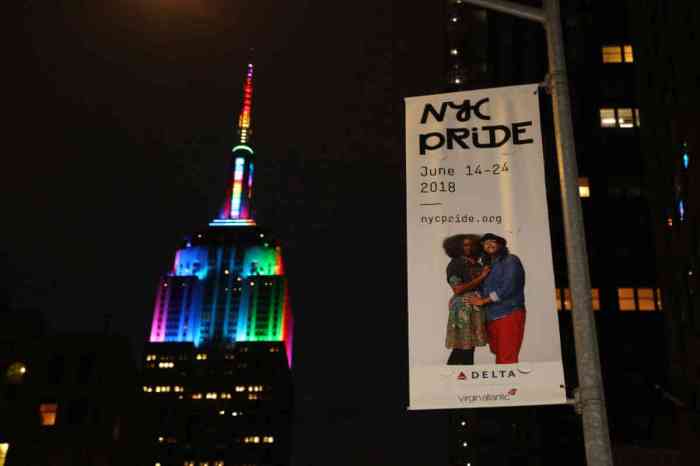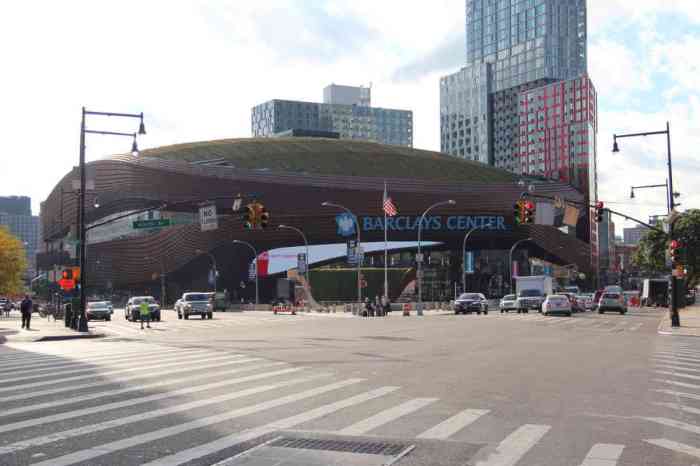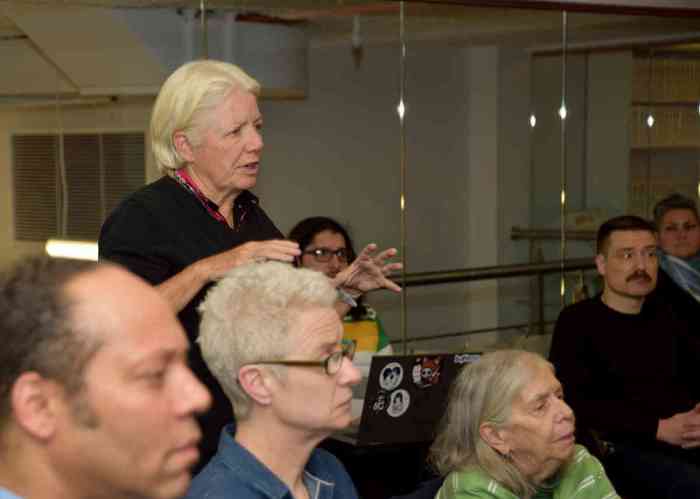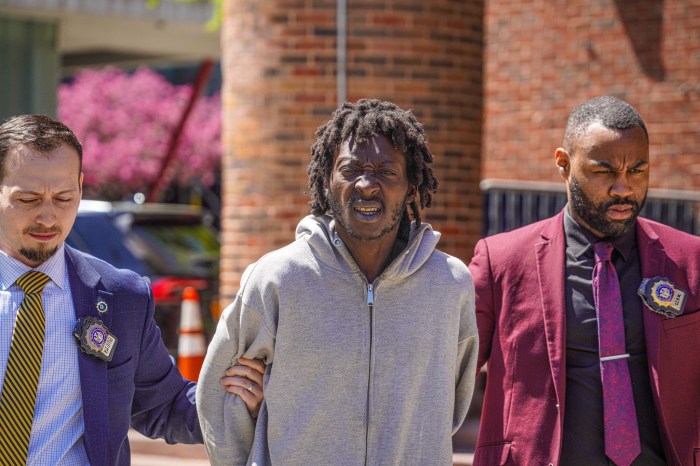Pier 97 at West 57th Street and the Hudson River will be the site of Pride Island, HOP dances to be held on June 23 and June 24 to close out the city’s annual Pride Month. | DUNCAN OSBORNE
Not a single marcher has set foot on any street or avenue to join New York City’s Pride Parade, but at least one Chelsea resident is threatening to sue the group that produces the annual event if it again attempts to stage the start of the parade in that neighborhood.
“For the future, this is not going to happen,” said Kimon Retzos, a co-president of the West 15th Street 100 and 200 Block Association, during a June 13 meeting with Heritage of Pride (HOP), the group that produces the parade and related events, and representatives from City Council Speaker Corey Johnson’s office. “We will get legal representation to stop this from happening.”
For the first time, the 2018 march will be staged in Chelsea, with contingents lining up on the blocks from 15th Street to 19th Street between Seventh and Ninth Avenues. The march will head south on Seventh Avenue then east on Christopher and Eighth Streets then north on Fifth Avenue to end at 29th Street.
With HOP expecting 43,000 marchers this year, Chelsea residents can expect the last contingent to leave the neighborhood at about 6:30 or 7 p.m. on June 24. HOP volunteers will arrive for set-up as early as 5 a.m. that day, though HOP has said in earlier meetings that its volunteers begin work at 4:30 a.m., so the staging could last for 13 or 14 hours.
In meetings last week, residents complain they only recently learned of plan
Detective Mike Petrillo, a community affairs officer in the 10th precinct, which covers Chelsea, said that clean-up should be completed by 8:30 p.m. on that Sunday assuming that HOP’s time estimate for the last step-off is correct.
Since the first march, which commemorates the 1969 Stonewall riots that mark the start of the modern LGBTQ rights movement, the route has gone from the West Village to Central Park or from Midtown to the West Village. The first parades were small with a few thousand marchers and were less disruptive in a residential neighborhood. As the parade has grown larger, it has been staged in Midtown, which is not a residential neighborhood, and headed downtown.
While the city has pressed all parades to limit their duration to no more than five hours, the Pride Parade has routinely run longer. It traditionally steps off at noon, and last year’s parade ended at 9:38 p.m. The parades in 2016 and 2015 were each about eight hours long. The route this year is a test for next year’s parade, which will mark the 50th anniversary of the Stonewall riots, and is expected to shave roughly 90 minutes off the run time.
The Chelsea residents at the June 13 meeting were uniformly opposed to staging the parade in Chelsea and were particularly angered that they were told this would happen only recently.
Bill Borock, president of the Council of Chelsea Block Associations, was first told of the plan in a May 22 email from Julian Sanjivan, HOP’s march director. Paul Groncki, president of the 100 West 16th Street Block Association, learned of the plan roughly two weeks before the June 13 meeting. Another resident, who left the meeting early, first heard of the plan by reading an article in Chelsea Now, a sister publication of Gay City News.
HOP first began discussing a new route for the 2018 parade in December 2016. It had a series of meetings on the route with city agencies, including the NYPD, beginning in August 2017. Ultimately, HOP presented the NYPD with six routes and that agency had selected one by January 22 of this year.
The new route is also controversial in the LGBTQ community.
City Council Speaker Corey Johnson, who is openly gay, was not informed of the route change until well after the decision was made, and he first learned about it by seeing a post on Facebook. Erik Bottcher, Johnson’s chief of staff, opened the meeting by saying of the new route, “We don’t like it.”
Midway through the meeting, Bottcher took the floor again to note that there was press in the room and expand on his comments.
“Last month, the speaker called the mayor’s office and said, ‘I want this route changed,’” Bottcher said and added that he then went to a meeting with the mayor’s office. “At the conclusion of that meeting, I made it clear that there is going to be a different process for picking the route next year.”
Sanjivan apologized for the lack of communication at a contentious June 5 town hall on the route that was held at the Lesbian, Gay, Bisexual & Transgender Community Center, and he apologized again at the June 13 meeting.
“I apologize,” he said after making a PowerPoint presentation to the residents. “We could have done a better job communicating.”
HOP’s march director Julian Sanjivan, Detective Carl Locke, the NYPD’s LGBTQ liaison, Patrol Borough Manhattan South Executive Officer James Kehoe, Patrol Services Bureau Executive Officer Fausto Pichardo, and Joseph Gallucci, the commanding officer of the NYPD’s citywide counterterrorism unit, at a June 5 town hall, the first of several meetings this month where HOP got blowback over its new parade route. | DONNA ACETO
It appears that Community Board 4, which covers the neighborhoods from 59th Street to 14th Street on Manhattan’s West Side, is generally unhappy with HOP’s handling of the Pride Parade and related events. Johnson once chaired that board.
“A lot of these same concerns were reflected last week at Community Board 4,” said Jeffrey LeFrancois, the 2nd vice chair on the board, at the meeting.
Dina Homayuni, an HOP staffer, attended the June 14 meeting of the board’s Waterfront, Parks & Environment Committee to finalize plans for HOP’s June 23 and 24 dances, called Pride Island, that will be held on Pier 97, which is at the end of West 57th Street on the Hudson River. As a member of that committee began to question Homayuni about the march, Lowell Kern, a committee co-chair, cut her off, noting that HOP had been “beaten up” enough at the prior week’s meeting and the night before. Kern had not attended the June 13 meeting, suggesting there is at least some conversation among residents and community board members outside of these meetings.
In a March agreement between HOP and Community Board 4, HOP agreed to take a number of steps to mitigate the sound coming from the dance and to sell no more than 5,250 tickets to the event. The issue of when the June 24 dance will end was unresolved, with HOP saying 11 p.m. and the board asking for 10 p.m.
At the June 14 meeting, Homayuni said the June 24 dance will be “completely done by 10:15” with the final 15 minutes for the fireworks display that ends Pride festivities.
HOP sold out the June 24 dance well before the June 14 meeting, but as of June 15 it was still showing 11 p.m. as the end time for the dance. James Fallarino, HOP’s media director, did not respond to an email asking if ticketholders, who presumably purchased tickets to a dance ending at 11 p.m., had been informed of the change.



































